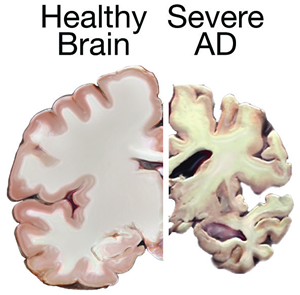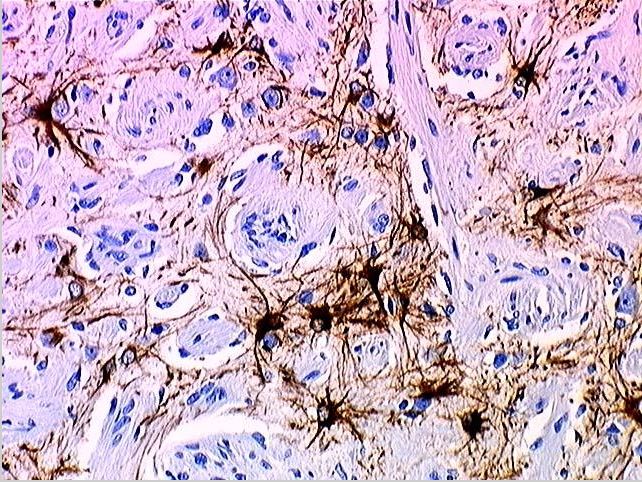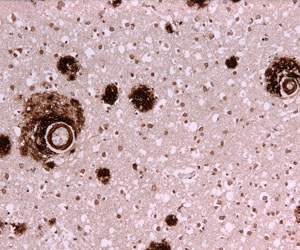Dementia Patients with dementia have symptoms such as memory loss and difficulties with thinking, problem-solving or language. The disorder is progressive, so the symptoms will gradually get worse. There are several types of dementia, the most common being Alzheimer's disease, which is a physical disease affecting the brain. During the course of the disease, protein 'plaques' and 'tangles' develop in the structure of the brain, leading to the death of brain cells. Generally speaking it is a disease of old age, but some people develop dementia as early as their forties. |
|
|
Alzheimer's disease (AD) results in the degeneration and death of neurones. The loss of neurones causes the thinning of the cortex and the reduction in the size of the brain. The pathological changes include the extracellular accumulation of a polymerised protein - beta amyloid - which leaves holes in the tissue, and the intracellular accumulation of neurofibrillary tangles. Much attention has been given to the role of cholinergic neurones in arousal, and the apparent loss of cholinergic neurones in the brain in Alzheimer's disease; the main pharmacological treatments of Alzheimer's disease utilize cholinergic agonists. More about cholinergic pathways in the brainstem and cortex. |
|
|
Neurofibrillary Tangles One characteristic change in neurones in Alzheimer's disease is the presence of neurofibrillary tangles, which are are collections of twisted protein threads present within nerve cells. Some of the pathological changes within CNS neurones in patients with Alzheimer's disease may be due to a disruption of axoplasmic transport by the microtubules.
Normal microtubules transport vesicles down the axoplasm, and the tubulin protein molecules are stabilised by the presence of a protein called tau. In Alzheimer's disease an abnormally large number of additional phosphate molecules are found to be attached to tau, and this allows the structure of microtubules to disintegrate; at the same time hyperphosphorylated tau joins with other filaments to form a sort of mesh. This leads to a total disruption of the internal communication within the nerve cell, and a failure of axonal transport in both directions. The loss of the internal transport systems of neurones result in an inability of activities of the nucleus, cell body and axon terminals to be coordinated, so the chemicals normally required at nerve endings may no longer be delivered to them. Synaptic transmission is therefore affected and neurones fail to communicate with each other. Failure of neuronal function of this magnitude can initiate the death of neurones, and affected regions of the cortex begin to shrink and the brain atrophies. In severe Alzheimer's disease brain shrinkage is widespread. |
|


